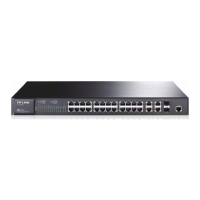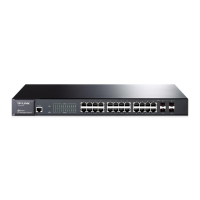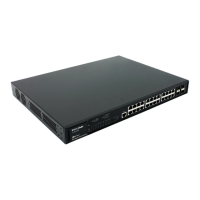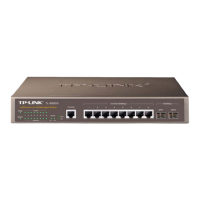Configuring Spanning Tree MSTP Configurations
User Guide 329
Step 3 spanning-tree
Enable spanning tree function for the desired port.
Step 4 spanning-tree common-config [ port-priority
pri
] [ ext-cost
ext-cost
] [ int-cost
int-cost
][
portfast { enable | disable }] [ point-to-point { auto | open | close }]
Configure the parameters on ports in CIST.
pri:
Specify the Priority for the desired port. The value should be an integral multiple of 16,
ranging from 0 to 240. The default value is 128. Ports with lower values have higher priority.
When the root path of the port is the same as other ports’, the switch will compare the port
priorities and select a root port with the highest priority.
ext-cost:
Specify the value of the external path cost. The valid values are from 0 to 2000000
and the default setting is Auto, which means the port calculates the external path cost
automatically according to the port’s link speed.
For STP/RSTP, external path cost indicates the path cost of the port in spanning tree. The Port
with the lowest root path cost will be elected as the root port of the switch.
For MSTP, external path cost indicates the path cost of the port in CST.
int-cost:
Specify the value of the internal path cost. The valid values are from 0 to 2000000.
The default setting is Auto, which means the port calculates the internal path cost
automatically according to the port’s link speed. This parameter is only used in MSTP.
For MSTP, internal path cost is used to calculate the path cost in IST. The port with the lowest
root path cost will be elected as the root port of the switch in IST.
portfast { enable | disable }
:
Enable to set the port as an edge port. By default, it is disabled.
When the topology is changed, the edge port can transit its state from blocking to forwarding
directly. For the quick generation of the spanning tree, it is recommended to set the ports that
are connected to the end devices as edge ports.
point-to-point { auto | open | close }
:
Select the status of the P2P (Point-to-Point) link to which
the ports are connected. During the regeneration of the spanning tree, if the port of P2P link
is elected as the root port or the designated port, it can transit its state to forwarding directly.
Auto indicates that the switch automatically checks if the port is connected to a P2P link, then
sets the status as Open or Closed. Open is used to set the port as the one that is connected to
a P2P link. Close is used to set the port as the one that is not connected to a P2P link.
Step 5 spanning-tree mcheck
(Optional) Perform MCheck operations on the port.
If a port on an RSTP-enabled/MSTP-enabled device is connected to an STP-enabled device,
the port will switch to STP compatible mode and send packets in STP format. MCheck is
used to switch the mode of the port back to RSTP/MSTP after the port is disconnected from
the STP-enabled device. The MCheck configuration can take effect only once, after that the
MCheck status of the port will switch to Disabled.
Downloaded from ManualsNet.com search engine

